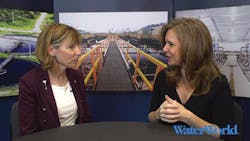Educating the public about the value of water
Editor’s Letter
Angela Godwin
Chief Editor, WaterWorld
Turn on the faucet, water comes out. Flush the toilet, it goes away. To the average American, that’s all there is to it. Communicating the before, after, and in between to the general public is an ongoing challenge in the water and wastewater industry — a challenge that current Water Environment Federation President Jenny Hartfelder takes to heart.
“We need to start educating the public about how they get their water when they turn on the tap [and] what happens after they flush the toilet,” she told me during an interview at WEFTEC.17.
Increasing public awareness of the value of water is something Hartfelder considers a personal passion. And when water and wastewater utility customers understand what happens behind the curtain (or below the ground, as it were), it can have far-reaching impacts.
Take funding, for example. There is only so much federal and state money to go around; the balance comes largely from ratepayers. Nobody enjoys the prospect of a rate increase — not the utility, not the municipality, and certainly not the customer.
Funding is one of the two biggest challenges in the industry, Hartfelder pointed out. “And that goes back to the public not understanding why they need to pay for clean water and why they need to pay for sanitation services.”
George Hawkins, the former CEO and general manager of DC Water, put it into eloquent perspective when we spoke last fall. “Everything we do depends on the relationship with the people who support us — both financially and in their neighborhoods when we’re doing the work,” he said. “There are often stories about how people don’t want to pay more for water and sewer, and my reaction is — of course they don’t! If you want me to pay more for a cup of coffee, my answer is: No. A hamburger: No. Shoes: No. I don’t want to pay more for anything — unless I know why. That value proposition must be made to the customer.”
Better communication with the public about the value of water has another benefit in the area of workforce development, the second big challenge in the water industry in Hartfelder’s view. “We’re seeing a generation that’s getting ready to retire,” she said. “We need to do a better job of reaching out to the young professionals and getting them to understand what options there are in the water industry.” And there are many, she noted, “from operators to scientists to regulators — and even to journalism and other industries that you don’t think of as in the wastewater field but that have a water connection.”
The key is education. “I feel like we’re a very humble industry,” said Hartfelder. “We don’t like to talk about what we do — but we need to start.” WW
About the Author

Angela Godwin
Editorial Director
Angela Godwin is the previous editorial director for Endeavor Business Media's Process/Water Group.
